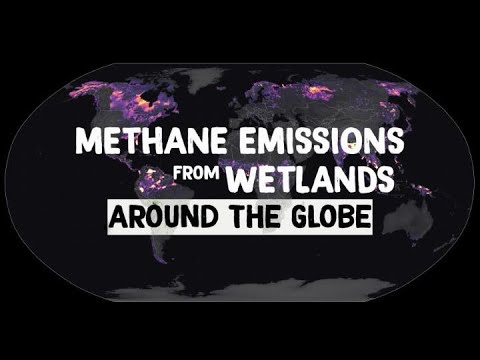How Does Methane Affect Global Warming and Environment
When NOAA released its 2020 numbers for atmospheric methane, many scientists were surprised by the significant increase. While economic data shows that lockdowns related to COVID-19 have led to improvements in air quality and reductions in carbon dioxide emissions, atmospheric methane is still rising — flat at 1900 parts per billion and nearly three times pre-industrial levels.
The annual rate of increase for 2020 is the highest recorded by scientists since systematic annual measurements of methane began in 1983 – an increase of 15 parts per billion, which will be surpassed again in 2021.
Climate scientists consider methane to be the second most important anthropogenic greenhouse gas after carbon dioxide. It is twenty-eight times more potent than carbon dioxide and, over 100 years, has contributed 15 to 45 percent of the 1.1°C (2°F) warming Earth has experienced since 1880.
The gas also contributes to the formation of tropospheric ozone, which is harmful to human health and agriculture. “The increase in growth rates in 2020 is big, unexpected and scary,” said Ben Poulter, a geoscience scientist at NASA’s Goddard Space Flight Center.
Methane concentrations peaked between 2000 and 2006, but they began to rise between 2007 and 2019, with an annual rate of increase of 9 parts per billion per year. For years, scientists have been trying to explain why methane concentrations in the atmosphere are rising so quickly, because there are many different processes that produce the gas and, on the other hand, the processes that remove it are difficult to measure.
Decomposition of organic matter in wetlands, extraction and use of fossil fuels, digestion by ruminants, burning of biomass by forest fires, melting of permafrost, decomposition of materials in landfills, spills into oceans and freshwater lakes, and termites are among the many sources.
“We don’t have all the data and monitoring capabilities we need to get a completely definitive answer as to why methane concentrations are rising so quickly,” Poulter said. But with the information we have, there appears to be strong evidence that increases in 2020 will significantly increase wetland emissions and, surprisingly, pollutant emissions reductions in nitrogen oxide (NOx) slowed indirectly by the COVID-19 lockdown. Removal of Methane from the Atmosphere” .
The findings were reported by an international team of scientists, including researchers from Peking University, Le Laboratoire des Sciences du Climat et de l’Environment (LSCE), Norwegian Aeronautical Research Institute, NOAA, NASA, California Institute of Technology, University of Maryland and Tsinghua University. in the journal Nature in December 2022.
The team reached its conclusions by analyzing a combination of emissions inventories from human activity data and modeling projections based on data from biogeochemical model simulations and atmospheric methane observations, said Jin Lin from LSCE. – Who led the study. They used data from Japan’s Greenhouse Gas Observing Satellite (GOSAT) and NASA satellites to help confirm their findings.
The research team attributed half of the 2020 methane rate increase to increased emissions from wetlands (Vertlands).
“Many of the world’s wetlands experienced unusually high temperatures and above-normal precipitation in 2020, particularly in the Northern Hemisphere. “Wetlands were nearly half a degree warmer than in 2019, and precipitation in global wetlands increased by 2 to 11 percent. “explains Suxi Peng, a geoscience expert at Peking University who led the study.
“This event may have caused the expansion of wetlands, bringing earlier ground thawing and later ground freezing dates.” A reduction in NOx emissions due to restrictions imposed due to Covid-19 accounted for the other half of the increase in growth rate, the team’s scientists said!
NOx is an air pollutant emitted from the burning of fossil fuels that triggers a chain of chemical reactions that produce a compound called hydroxyl (OH). It acts as an atmospheric “detergent” by reacting with methane and removing it from the atmosphere, Lin explained. As NOx emissions are reduced, so is its impact on methane.

The above map provides an overall projection showing where NOx emissions will decrease in 2020 due to reduced transportation and industrial activity during the first year of the COVID-19 pandemic. Densely populated areas in North America, Europe and Asia have declined significantly (purple).
The map is based on data from the Community Emissions Data System, supported in part by NASA’s Atmospheric Composition Modeling and Analysis Program. Extended to 2020 based on near-real-time anthropogenic emissions from the Carbon Monitor Program.
“Our research on the 2020 spike also reminds policymakers that they cannot look at pollutants in isolation. “There’s a ripple effect in cleaning up NOx that they need to consider when thinking about how to manage methane emissions,” Poulter said.
Because methane is such a potent greenhouse gas, especially in the short term, many climate scientists say limiting methane emissions is one of the most promising ways to slow the rate of global warming and meet the goal of limiting that warming to 1.5-2 to. C above pre-industrial temperatures.
But there are no signs of this happening yet. The methane growth rate in 2021 is higher than the 2020 rate, increasing from 15.3 parts per billion in 2020 to 17 parts per billion in 2021.
“We need to do more analysis to confirm the conclusions, but my fear is that we are seeing the beginning of a worrisome feedback loop in which we are driven to heavier rains and higher temperatures, which in turn drives us to more methane emissions and ultimately more temperature and so on,” Poulter said. .

